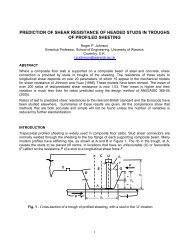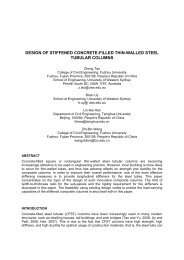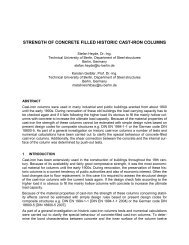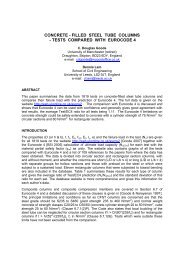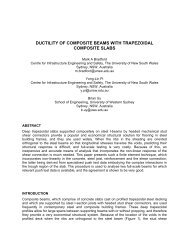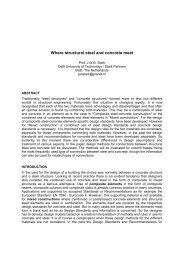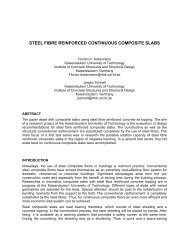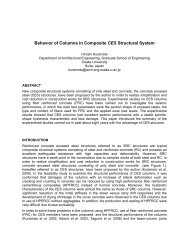developing composite action in existing non-composite steel girder ...
developing composite action in existing non-composite steel girder ...
developing composite action in existing non-composite steel girder ...
Create successful ePaper yourself
Turn your PDF publications into a flip-book with our unique Google optimized e-Paper software.
connectors. All specimens were an 11.6-m long simply supported beam, with a concentratedload applied at midspan. For all specimens, the <strong>steel</strong> beam was a W30x99 section of ASTMA922 <strong>steel</strong>. The re<strong>in</strong>forced concrete slab was 2130-mm wide and 178-mm thick, with a specifiedconcrete compressive strength of 20.7 MPa. Details are shown <strong>in</strong> Fig. 3.Figure 4 shows the computed load-carry<strong>in</strong>g capacity of the test specimens with respect to theshear connection ratio from simple plastic analysis. These beam strength values werecalculated us<strong>in</strong>g the m<strong>in</strong>imum specified concrete strength ( f 'c= 20.7 MPa) and the m<strong>in</strong>imumspecified yield stress of the <strong>steel</strong> ( Fy= 345 MPa). The contribution of the longitud<strong>in</strong>alre<strong>in</strong>forc<strong>in</strong>g bars was neglected <strong>in</strong> the strength calculation. The m<strong>in</strong>imum specified tensilestrength of ASTM 193 B7 threaded rod for the DBLNB and HASSAA connectors and ASTMA325 high-strength bolt for the HTFGB connectors is 862 MPa and 827 MPa, respectively.Based on these calculations, the <strong>non</strong>-<strong>composite</strong> beam has a capacity of 609 kN. As shown <strong>in</strong>Fig. 4, add<strong>in</strong>g shear connectors significantly <strong>in</strong>creases the computed load capacity of this beam,even with low values of shear connection ratio. Based on this analysis, it was decided to designthe four partially <strong>composite</strong> beam specimens with a 30-percent shear connection ratio, result<strong>in</strong>g<strong>in</strong> a predicted <strong>in</strong>crease of 48 percent <strong>in</strong> load-carry<strong>in</strong>g capacity compared to the <strong>non</strong>-<strong>composite</strong>beam. To achieve a 30-percent shear connection ratio requires 16 shear connectors for eachshear span (a total of 32 shear connectors for a beam). The shear connectors were 22 mm (7/8<strong>in</strong>.) <strong>in</strong> diameter, and their static strength was predicted us<strong>in</strong>g Eq. 3.The specimen designations used below beg<strong>in</strong> with the connection method, followed by theshear connection ratio <strong>in</strong> percentage. “BS” stands for Beam Static test.1782134305 #5 & #4 @152#4@305Load (kips)12001000800901 kN1048 kNW30x99Unit: mm600609 kN 30%0 0.2 0.4 0.6 0.8 1Shear connection ratio (N/N f )Figure 3 – Details of specimen cross sectionFigure 4 – Predicted load capacity of testspecimens versus shear connectionMaterial propertiesMechanical properties of structural components used <strong>in</strong> the test specimens are shown <strong>in</strong> Table1. Concrete for the specimens was delivered by ready-mix truck. The specified compressivestrength was 20.7 MPa with 19-mm river aggregate. Five Star ® Highway Patch, a fast-sett<strong>in</strong>ghigh-strength grout, was used to fill the hole <strong>in</strong> the concrete slab after <strong>in</strong>stallation of the DBLNBand HTFGB connectors. Hilti HY 150 adhesive was used for the HASAA connectors.The <strong>steel</strong> beams used for the full-scale beam tests were of ASTM A992, which has a m<strong>in</strong>imumspecified yield stress of 345 MPa. Steel coupons were taken from both the beam web and theflange. The Grade 60, #4 longitud<strong>in</strong>al re<strong>in</strong>forc<strong>in</strong>g bars used <strong>in</strong> the specimens were also tested <strong>in</strong>tension to evaluate mechanical properties. The ultimate tensile strength of the ASTM A193 B7




